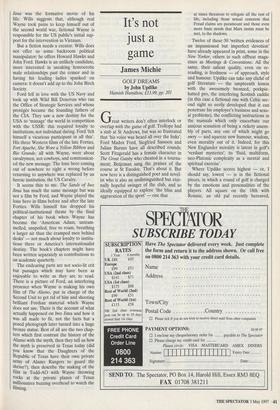Casting a giant shadow
John Bowen
JOHN WAYNE: THE POLITICS OF CELEBRITY by Garry Wills Faber, £.20, pp. 380 This book is vexing but endearing. Both qualities are shown from the beginning when Wills, like a Nutty Professor, tells us that he proposes to exclude all evidence not useful to his hypothesis. Thereafter the professor hangs around like a persistent guide at an historical monument. There are references to The Odyssey, to Cicero and Ovid, a deal of Emerson, Captain Ahab of course, lit crit categories (Stagecoach is not a 'Western' but a 'ship of fools' story) and there's a fine old squabble with Tag Gallagher, another toiler in this field, about the symbolism of the final walk away in The Searchers which has the genuine ring of academic acerbity.
The book is not a biography of John Wayne. Wayne's private life is outside its `scope'. Wills is concerned with Wayne as a fictional character and delves more deeply into the psyche of his director, John Ford, than that of Wayne himself, who is not allowed to have a psyche, just a way of walking on camera — 'His whole character seems to be an extension of the calm authority of his walk.'
As for 'the politics of celebrity', it does not mean anything as simple as the appear- ance of William Roache (Ken Barlow in Coronation Street) standing foursquare by the side of Neil Hamilton in Tatton to prove innocence-by-association. What Wills seems to mean is the use of a success- ful fictional creation — the continuing character of John Wayne as developed throughout the films in which he appears — to justify a certain sort of right-wing political ethos. Example: Newt Gingrich told an interviewer that The Sands of Iwo Jima was the formative movie of his life. Wills suggests that, although real Wayne took pains to keep himself out of the second world war, fictional Wayne is responsible for the US public's initial sup- port for the intervention in Vietnam.
But a fiction needs a creator. Wills does not offer us some backroom political manipulator; he offers Howard Hawks and John Ford. Hawks is an unlikely candidate, more interested in sneaking homoerotic male relationships past the censor and in having his leading ladies spanked on camera: it doesn't add up to the John Birch Society.
Ford fell in love with the US Navy and took up with Wild Bill Donovan who ran the Office of Strategic Services and whose protégés became the founding fathers of the CIA. They saw a new destiny for the USA to 'manage' the world in competition with the USSR: this required loyalty to institutions, not individual daring. Ford 'felt himself a vicarious participant in all this'. His three Western films of the late Forties, Fort Apache, She Wore a Yellow Ribbon and Rio Grande, all with Wayne, were about cavalrymen, not cowboys, and communicat- ed the new message. The lone hero coming out of nowhere to right a wrong before returning to anywhere was replaced by an heroic institution, the US Cavalry.
It seems thin to me. The Sands of Iwo Jima has much the same message but was not a film by Ford, and Wayne played the lone hero in films before and after the late Forties. Wills himself has dropped his political-institutional theme by the final chapter of his book when Wayne has become the 'American Adam, untram- melled, unspoiled, free to roam, breathing a larger air than the cramped men behind desks' — not much about loyalty to institu- tions there or America's internationalist destiny. The book's chapters might have been written separately as contributions to an academic quarterly.
The endearing parts are not socio-lit crit but passages which may have been as enjoyable to write as they are to read. There is a picture of Ford, an interfering presence when Wayne is making his own film of The Alamo, put in charge of the Second Unit to get rid of him and shooting brilliant Fordian material which Wayne does not use. There is the account of what actually happened on Iwo Jima and how it was all made to fit, not the facts but a posed photograph later turned into a huge bronze statue. Best of all are the two chap- ters which first contrast the history of the Alamo with the myth, then they tell us how the myth is preserved in Texas today (did you know that the Daughters of the Republic of Texas have their own private army of Alamo Rangers to guard the shrine?), then describe the making of the film in Todd-AO with Wayne throwing rocks at the private planes of Texan millionaires buzzing overhead to watch the filming.



































































 Previous page
Previous page